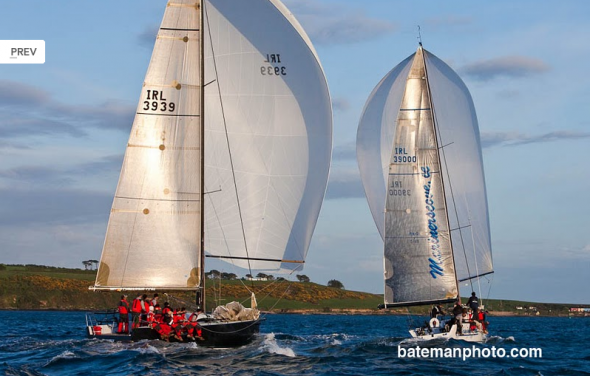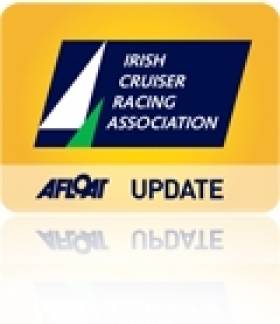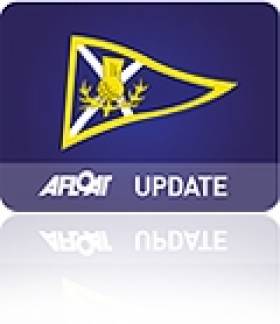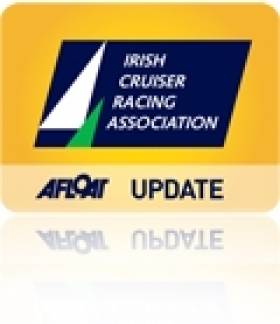Displaying items by tag: Commodores Cup
Five Boats Fight for ICRA's Offshore Honours
Only five boats came to the line for the inaugural Irish Cruiser Racer Association (ICRA) Offshore Trophy at Crosshaven tonight but what the sailing fleet lacked in numbers it made up for in close competition inside Cork Harbour. Under spinnaker Marinercove.ie (Dave Dwyer) led Antix (Anthony O'Leary) out past Roches Point but only by the narrowest of margins. Also heading for Dublin Bay tonight and next week's ICRA National Championships is Andrew Creighton's brand new Roxy 6, Gloves off and D-Tox. Departing on an ebb tide and 12-knot northerly winds the sailors can expect lighter conditions on the east coast over night. Pictures by Bob Bateman later on the Afloat gallery.

French Present Main Challenge for O'Leary in Scotland
In preparation for this year's Commodore's cup ICRA members will be interested to know that France is fielding a strong sailing challenge at the Scottish series in two weeks time which means Royal Cork's Anthony O'Leary will get all the competition he is looking for and more when he arrives on Lough Fyne.
Both French teams will compete in IRC Class 1 at the Brewin Dolphin Scottish Series up against two previous winners of the overall Scottish Series Trophy, Ireland’s Anthony O’Leary on the Ker 39 Antix and three times winner Jonathan Anderson on Playing FTSE.
The magic of the Brewin Dolphin Scottish Series continues to spread into Northern Europe and the premier regatta in the north of Britain has drawn two key French entries among the fleet which is set to muster on Loch Fyne from May 28-31st.
The regatta has become a firm favourite with a small number of French skippers and crews and there have been regular visits from competitors from Brittany and beyond.
In particular, as well as the excellent IRC handicap racing, the French visitors who make the long passage up the Irish Sea enjoy the relaxed ambience of the regatta and this historic, picturesque setting of Tabert which is similar to their native coastline.
In 2008 the overall Scottish Series Trophy went to France for the first time when Gery Trentesaux skippered and steered his La Trinite based Beneteau First 45 to win Class 1. Trentesaux had been one of the most regular visitors from France over the recent history of the Scottish Series. Twice Trenteseaux has captained victorious teams to win the Rolex Commdore’s Cup, the most sought after international offshore racing team Trophy, but he has been a Scottish Series disciple for many years, spreading the word to his compatriots.
Jacques Pelletier is from the same mould as Trenteseaux, a keen offshore racer who enjoys the challenge of travelling to regattas and races which interest him and his crew. He was due to race last year but had to withdraw at the last minute, but raced at Tarbert three times before, most recently in 2008.
He, too, has twice represented France in the Commodore’s Cup. A retired businessman from Paris, Pelletier has done seven Figaro races across the Atlantic.
Newcomers this year are the St Malo based crew of the J122 Nutmeg IV, owned and skippered by Francois Lognone.
“It is the first time we come to Scotland to race but all of our French friends who have already raced in past years at Tarbert always return talking of the magic. So this year we will race, and go on and do a little bit of cruising. We have had the boat for three years, but from St Malo we regularly compete at Cowes Week, the Fastnet and the Round the Island race. But we are not at the same level as Géry Trentesaux!” remarks Lognone.
Ends
Welcome Roxy 6 to the Royal Cork Yacht Club
The Davies/Creighton Corby 36 has made a very welcome appearance on the marina at the Royal Cork Yacht Club writes Claire Bateman. She was recently completed at the Dale-Nelson Yard in Wales. She is built of strip cedar and is a close clone of Quokka 7.
Roxy 6 is expected to sail for an Irish team from Royal Cork Yacht Club. She will be the Class Three representative in the biennial Rolex Commodores’ Cup, an intense seven day racing programme that will take place on the testing waters in and around the Solent from August 15th to 21st, 2010. Class Two will be represented by David Dwyer’s Marinerscove.ie, recent winner of Class Zero at the Kinsale Spring Series. Class One is to be represented by Anthony O’Leary, now the new owner of Antix, a boat he chartered from Colm Barrington in 2008 that was the top scoring boat in its class at the 2008 Commodores’ Cup event.
The Class Bands are as follows:
Class One 1.110 to 1.230
Class Two 1.075 to 1.119
Class Three 1.025 to 1.074
Ireland is entitled to send up to four teams of three boats but currently there is no word of any other team emerging.
The programme for the team is as follows: They will compete in the feeder race from the Royal Cork on May 14th to the Liebherr ICRA Nationals that will take place in Dun Laoghaire from May 21st to 23rd. Antix and Roxy 6 will compete at the Scottish Series from May 28th to 31st. Marinerscove.ie will not compete at this event. The full team will regroup for the British IRC National Championships at Cowes from June 25th to 27th at which event Dave Dwyer in Marinerscove.ie will defend his title. This Championship is mandatory for the British Commodores’ Cup teams to compete in. After this its back to Royal Cork for Cork Week from July 10th to 16th. It is hoped the French and British teams will also compete at Cork Week. Finally they will head for the big one, the Commodores’ Cup in August, an event that we have just missed out on for the last two occasions and have some unfinished business we hopefully can settle this time round.


























































